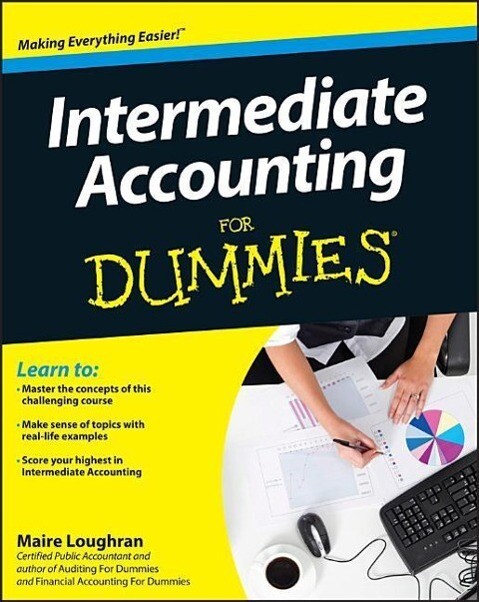Learn to:
- Master the concepts of this challenging course
- Make sense of topics with real-life examples
- Score your highest in Intermediate Accounting
The painless way to master an Intermediate Accounting course With easy-to-understand explanations and real-world examples, Intermediate Accounting For Dummies takes the confusion out of the topics you'll encounter in this challenging course: Generally Accepted Accounting Principles (GAAP), International Financial Reporting Standards (IFRS), financial ratio analysis, equity accounting, investment strategies, financial statement preparation, and more.
- Financial Accounting 101 -- get acquainted with the role and responsibilities of financial accountants
- Make a statement -- walk through the proper preparation of the income statement, balance sheet, and statement of cash flow
- Control your cash -- discover everything you need to know about accounting for current and noncurrent assets
- I.O.U. -- find the 4-1-1 on debt and equity, short-term claims payable by the company, and accounting for long-term obligations under various debt scenarios
- Mistakes happen -- find out how to fix mistakes in financial statements, how to account for a change from one accounting method to another, and what to do when an accounting estimate is incorrect
Open the book and find:
- The conceptual framework of financial accounting
- The elements of financial statements
- All about the accounting system
- Lots of examples of worksheets and reports
- How a business prepares an income statement
- The ins and outs of cashflow
- The time value of money
- Ways to analyze debt and equity
- Ten common disclosure notes to the financial statements
Inhaltsverzeichnis
Introduction 1
Part I: Introducing Financial Accounting and Standards 7
Chapter 1: Seeing the Big Picture of Financial Accounting 9
Chapter 2: Walking Through the Conceptual Framework of Financial Accounting 23
Chapter 3: Invaluable Valuation 43
Chapter 4: Reviewing the Accounting System 51
Part II: Preparing and Using Financial Statements 65
Chapter 5: Posting Income Statement Profit and Loss 67
Chapter 6: Reporting Assets and Claims: Keeping Your Balance (Sheet) 83
Chapter 7: Follow the Money! Studying Cash Flow 101
Chapter 8: Time Is Money: Looking at the Time Value of Money 115
Part III: Homing in on Current and Noncurrent Assets 127
Chapter 9: Assessing Cash and Receivables 129
Chapter 10: Inventory Cost Flow Assumptions 145
Chapter 11: Buying and Selling Property, Plant, and Equipment (PP&E) 167
Chapter 12: Recognizing Depreciation, Impairments, and Depletion 183
Chapter 13: Keeping Track of Other Noncurrent Assets 197
Part IV: Analyzing Debt and Equity 207
Chapter 14: Tracking Current Liabilities and Contingencies 209
Chapter 15: Planning for Long-Term Obligations 227
Chapter 16: Letting Owners Know Where They Stand: The Equity Section 241
Part V: Accounting for Advanced Intermediate Issues 257
Chapter 17: Accounting for Income Taxes 259
Chapter 18: Accounting for Leases 277
Chapter 19: Fessing Up: Correcting Errors
and Reporting Changes in Methods 295
Chapter 20: Is That You, Revenue? Revenue Recognition Concepts 313
Part VI: The Part of Tens 327
Chapter 21: Ten Common Notes to the Financial Statements 329
Chapter 22: Ten Ratios for Financial Statement Analysis 337
Index 343










